
The Anne Spencer House, in Lynchburg, Virginia, United States was, from 1903 to 1975, the home of Anne Spencer, a poet of the Harlem Renaissance.

Carter Glass House is a historic house at 605 Clay Street in Lynchburg, Virginia. Built in 1827, it is nationally significant as the longtime home of United States Congressman, Senator, and Treasury Secretary Carter Glass (1858-1946), who championed creation of the Federal Reserve System and passage of the Glass-Steagall Act, which constrained banking activities. The house was designated a National Historic Landmark in 1976. It now serves as a parish hall for the adjacent St. Paul's Church.
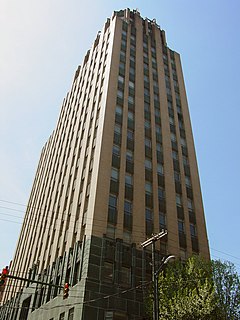
The Allied Arts Building is a historic high-rise building located at 725 Church Street in Lynchburg, Virginia. It is currently being remodeled for apartments.
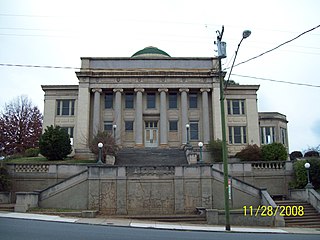
The Jones Memorial Library Building is a historic library building located on Rivermont Avenue at Lynchburg, Virginia. It was designed by the local architectural firm of Frye & Chesterman. It was erected in 1906–07 in the Neo-Classical Revival style.
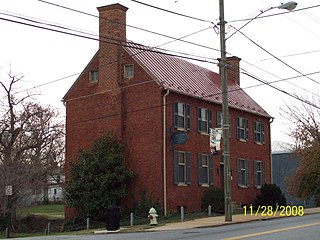
The Kentucky Hotel is a historic hotel building located at Lynchburg, Virginia. It is one of Lynchburg's three remaining early 19th century ordinaries. It was probably built before 1800, and is a 2+1⁄2-story structure of brick laid in Flemish bond. In about 1814, two side bays were completed, converting the house to a center hall plan.

Point of Honor is an historic home, now a city museum, located in Lynchburg, Virginia. The property has commanding views of the city and the James River. Its name originated due to the land on which it is built being used as a clandestine dueling ground.

Historic Sandusky is a historic home located in Lynchburg, Virginia. It is a formal two-story, brick "I" house built about 1808, with a later addition. It was built by Charles Johnston, and is one of the earliest homes in the Lynchburg area to display the architectural details and refinements characteristic of Federal design.

John Marshall Warwick House is a historic home located at Lynchburg, Virginia. It was built in 1826 by prominent Lynchburg tobacconist and city mayor (1833), John Marshall Warwick. It was one of the first houses to be built on the crest of Lynchburg Hill, later to be called Court House Hill, overlooking the James River. It exhibits the transition from the Federal to the Greek Revival styles. His grandson, United States Senator John Warwick Daniel was born in this home.
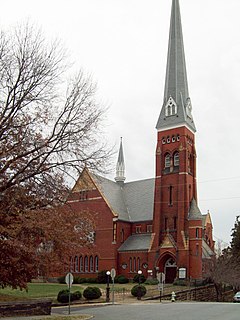
First Baptist Church is a historic Baptist church located at 1100 Court Street, Lynchburg, Virginia. It is built of hard-pressed red brick on a rough granite foundation. The main facade of the church, facing Eleventh Street, and the two sides are centered with large rose windows framed within Gothic arches covered with hood moldings. Construction began in 1884 and the church was dedicated in 1886. In the 1920s, Lynchburg architect Stanhope S. Johnson designed the complementary Sunday School annex. In 1941, the interior of the sanctuary was modified by Stanhope S. Johnson, with the creation of a divided chancel. It is home to the oldest Baptist congregation of Lynchburg, established in July 1815. Current as of 2020, First Baptist Church is affiliated with the Cooperative Baptist Fellowship (CBF).

St. Paul's Church is a historic Episcopal church in Lynchburg, Virginia, United States.
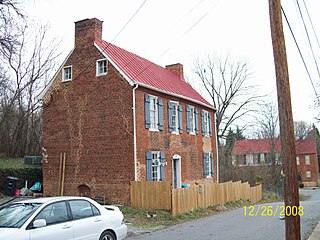
The William Phaup House is a historic home located in Lynchburg, Virginia. It is a modest two story, four bay Federal style brick dwelling constructed about 1817. It is named after its architect and original occupant, William Phaup. Very few alterations have been made to the house since its construction.

The Court House Hill–Downtown Historic District is a national historic district located in Lynchburg, Virginia. The area is situated on a promontory overlooking the Lower Basin Historic District on the south bank of the James River. The approximately 50-acre (200,000 m2) district is composed of relatively intact city blocks of religious, commercial, residential, and governmental buildings and structures ranging in date from the early 19th century to the mid-20th century. Buildings in the district represent a variety of styles from the different periods, including the Federal, Greek Revival, Gothic Revival, Italianate, Queen Anne, Neoclassical, Italian Renaissance, Spanish Eclectic, Craftsman, and Art Deco styles.

The Lynchburg Courthouse is a historic courthouse building located at Lynchburg, Virginia. Built in 1855, it occupies a prominent position overlooking the steeply descending steps of Monument Terrace. The building is executed in stucco-over-brick on a granite ashlar basement and is an example of the Greek Revival. The building is capped by a shallow dome located over the intersection of the ridges. At the top of the dome is a small open belfry consisting of a circle of small Ionic columns supporting a hemispherical dome. The front of the court house has a three-bay Doric portico.
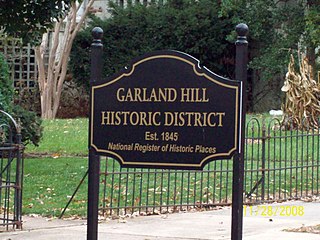
The Garland Hill Historic District is a national historic district located in Lynchburg, Virginia. The area is a small residential neighborhood incorporating the summit of one of the numerous hills surround downtown Lynchburg. The neighborhood was home to many of Lynchburg's oldest and most distinguished families, many of whom were associated with the tobacco industry. Buildings in the district represent a variety of styles from the early 19th century through the early 20th century including the Gothic Revival, Victorian, and Queen Anne styles, some of which were designed by Lynchburg architects Edward Frye and Stanhope S. Johnson.

The Federal Hill Historic District is a national historic district located in Lynchburg, Virginia. The district includes some one dozen residential blocks in the heart of Lynchburg spread over 33 acres (130,000 m2). The district's architecture consists primarily of free-standing brick or frame houses in a variety of styles but of harmonious scale. Included are three important French Second Empire houses standing near one another on Harrison Street. There is also a notable assemblage of free-standing dwellings in architectural styles ranging in date from the early 19th century through the Edwardian styles of the early 20th century. There is an important collection of early Federal-style townhouses.

The Rivermont Historic District is a national historic district located in Lynchburg, Virginia. It is a 192.10-acre (0.7774 km2) district consisting of the 300-3400 blocks of Rivermont Avenue as well as Riverside Park and a few properties alongside streets that face onto Rivermont Avenue. It is bounded by the James River on the east and northeast, Blackwater Creek on the east and southeast, Daniel's Hill on the north and Virginia Episcopal Road and the southern end of Boonesboro Road.

The Batesville Historic District is a national historic district located at Batesville, Albemarle County, Virginia. In 1999, when it was listed on the National Register of Historic Places, it included 33 buildings deemed to contribute to the historic character of the area. They include representative examples of the early-19th century Federal Style, the mid-19th century Greek Revival Style, simple late-Victorian styles from the late-19th century- and early-20th century, Classical Revival and Colonial Revival styles. Notable buildings include the Batesville Elementary School (1922), Batesville Public School, Mount Ed Baptist Church, Batesville Methodist Church (1861), Dr. Smith House, the Barskdale House, Hill House, and Page's Store.

Salem Veteran Affairs Medical Center (VAMC) is one of the largest VA hospitals located at 1970 Roanoke Blvd. Salem, Virginia 24153. Since 1934 VAMC in Salem has been improving the health of the men and women who have so proudly served the United States Navy, United States Army, United States Air Force, United States Coast Guard and United States Marines. Health care services have been provided to more than 112,500 veterans living in a 26-county area of southwestern Virginia. Salem VAMC provided community-based outpatient clinics. In addition to the main facility in Salem, there are affiliated services in three community-based outpatient clinics. These clinics are located in Danville, Hillsville, Lynchburg, and Tazewell, Virginia, Wythville.11
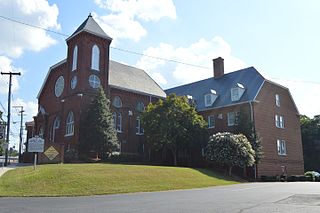
Diamond Hill Baptist Church is a historic African-American Baptist church located at Lynchburg, Virginia. It was built in 1886, and is a three-story, "L"-shaped, brick church building in the Late Gothic Revival style. It has brick buttresses capped with limestone, Gothic pointed arched windows, a three-story entrance tower with steeple, and a jerkinhead roof. From 1958 to 1963 the pastor was Virgil Wood, the pastor most associated with the Civil Rights Movement in Lynchburg.

The Winchester Historic District is a national historic district located at Winchester, Virginia. The district encompasses 1,116 contributing buildings in Winchester. The buildings represent a variety of popular architectural styles including Late Victorian and Italianate. They include residential, commercial, governmental, industrial, and institutional buildings dating from the 18th to mid-20th centuries. Notable buildings include the A.M.E Church (1878), Masonic Lodge and Gray and Eddy Building, First Presbyterian Church, Farmers and Merchants Bank (1902), Frederick County Courthouse (1840), Grace Lutheran Church, Friendship Fire Hall (1892), John Kerr School, City Hall (1900), Lewis Jones Knitting Mill (1895), Tidball Residence, William F. Hottle Residence, McGuire Residence, and Robert Long House. Located in the district are the separately listed Thomas J. Jackson Headquarters, Fair Mount, Handley Library, Adam Kurtz House, and Daniel Morgan House.



























